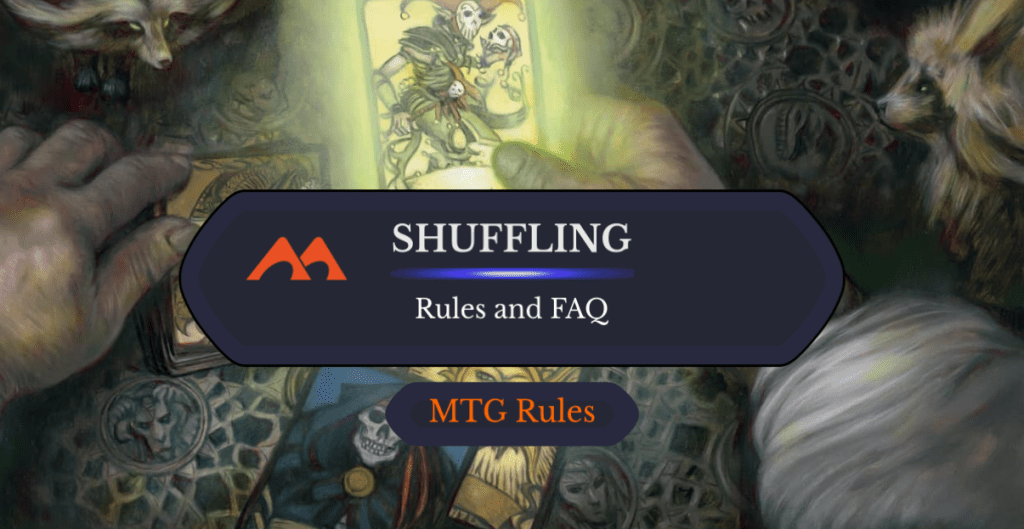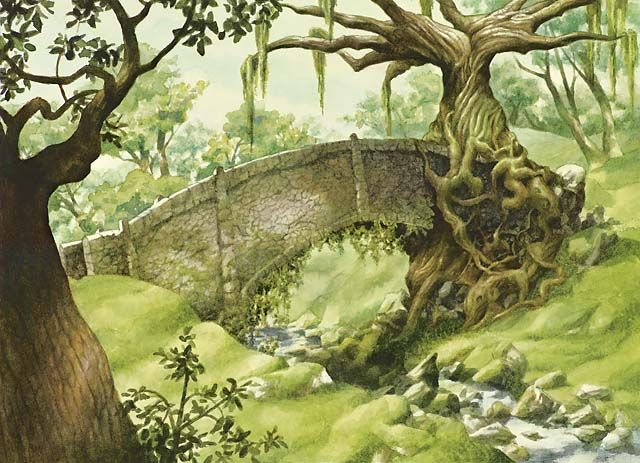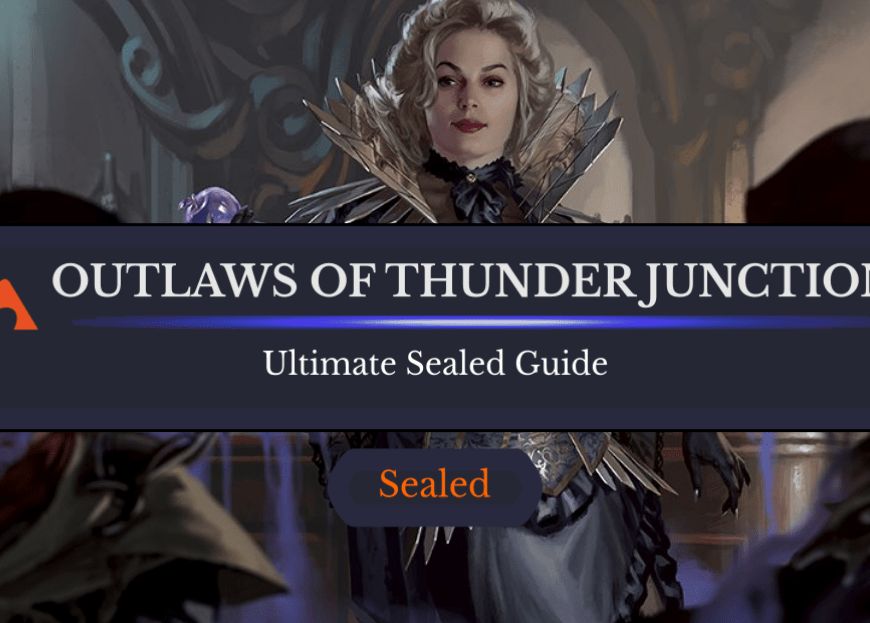
The Deck of Many Things | Illustration by Volkan Baga
Shuffling is something that every Magic player must do at least once at the beginning of the game. However, between tutors, fetch lands, land ramp, and other library-searching effects you’re likely to shuffle your deck many times throughout a game. If you play on MTG: Arena or MTGO then the client handles all the shuffling but you need to do it yourself when playing tabletop Magic.
Shuffling seems like a very basic action but can be quite complex. It’s important to ensure you shuffle fairly and appropriately so everybody has a good time. What do the rules say about shuffling in Magic? And are you shuffling correctly?
Today, I’m diving into this complex topic to answer all your questions about shuffling!
What is Shuffling?

Mosswort Bridge | Illustration by Jeremy Jarvis
Shuffling is the act of randomising the cards in your library (deck). This happens at the start of a game and whenever you search your library for a specific card(s). You shuffle after searching with cards like Rampant Growth and Demonic Tutor so you don’t know the order of your deck. Other effects can make you shuffle, like Chaos Warp. Any card that wants you to shuffle your library specifies so.
There’s more than one way to randomise your deck, but anytime you shuffle, you must ensure that the deck is completely random (or as close as reasonably possible). It’s a matter of fairness. One player knowing the order of their deck while another doesn’t gives them a crucial, unfair edge.
Shuffling Rules
Shuffling requires you to randomise your deck until no player taking part has any knowledge of the order/position of its cards. This includes individual cards or a general idea of where groups of cards may be. This happens if you ‘mana weave’ by creating a pattern of lands to non-lands in your deck.
The rules state that once you’ve randomised your deck, you should pass it to your opponent for an extra shuffle. This doesn’t need to be thorough; it just ensures you haven’t shuffled your deck in a non-random manner. In competitive events, if a players thinks their opponent has purposefully or accidentally shuffled inadequately, they must call a judge.
The Magic Tournament Rules (MTR) has a complete breakdown of the rules regarding shuffling your Magic deck. Now, let’s examine the most common shuffling techniques.
Shuffling Techniques
(Dis)honourable mention. Pile Shuffling
Despite ‘shuffling’ being in the name, the pile shuffling technique doesn’t actually randomise your library. Pile shuffling is the act of making smaller piles with your deck by placing a card in each pile one at a time. This reorders rather than randomizes the cards. If you knew the position of any individual card as you pile shuffled, you would still know the card’s position once you were finished.
You can pile shuffle once in competitive Magic tournaments to count the number of cards in your deck, but it doesn’t count as randomising your library.
Overhand Shuffle
The overhand shuffle is the basic technique for a standard deck of playing cards and probably the first way you learned to shuffle. You place small blocks or chunks of cards from one side of the deck to the other. Whilst this is quick and easy to do, you must do it several times for adequate randomization.
Mash Shuffle
The technique I see most Magic players use is mash shuffling. You take two piles of cards (probably halves of your deck in smaller deck formats) and push them together so the cards interweave. This is an easy and effective shuffling method that works well with sleeved cards. Mash shuffling is much harder with an unsleeved deck and can damage the edges of unsleeved cards when done improperly.
One thing to consider with this technique is that mash shuffling can leave one card on the top or bottom of a library. Keep an eye out so you don’t make this mistake and to make sure your opponent mash shuffles honestly.
Riffle Shuffle
When somebody shuffles a deck of cards in a casino or the movies, they typically use the riffle shuffle technique. You separate the cards into two piles, lift the corners up, and ‘flick’ them together, weaving the cards into one deck.
Whilst visually impressive and effective at randomising your deck, most Magic players don’t use this technique because riffle shuffling can damage cards and sleeves. Because of this, you should avoid riffling shuffling somebody else’s deck.
Combination of Techniques
A combination of the above techniques is likely the best way to properly randomize your deck. Personally, I do a handful of mash shuffles with an overhand or two. As long as you don’t waste time and your deck is sufficiently randomised, use whatever technique you want!
What Shuffling Techniques Are Allowed in Tournaments?
There isn’t an approved list of shuffling techniques for tournament play. Any method that adequately randomises your deck and doesn’t take too long works.
What Shuffling Techniques Are Allowed When Shuffling Your Opponent’s Deck?
You can shuffle your opponent’s deck with any technique you would use on your own cards. However, you cannot use any technique that could damage your opponent’s cards. This is why you should avoid riffle shuffling an opponent’s deck.
How Long Can You Spend Shuffling?
There is currently no hard limit on the amount of time you can spend shuffling your deck. However, judges can issue slow play warnings at sanctioned events if you take too long. Do your best to randomize adequately then stop shuffling. Seven or so mash shuffles should sufficiently randomise your deck.
Can You Have Help Shuffling?
There are specific cases where you can have someone else help shuffle your deck. The most common is if you have an injury or disability which prevents you from shuffling your deck. In this case you can either have a supporter assist your shuffling or a judge. If this applies to you and you’re attending an organised play event, contact the Tournament Organiser ahead of time to discuss the best options.
Is Pile Shuffling Legal?
Pile shuffling is legal in competitive events. However, it should only be carried out once per game as a method to check that your deck has the correct number of cards rather than as a randomisation technique. After pile shuffling, you must use another shuffling method to ensure proper randomisation before the game begins.
Is Mana Weaving Legal?
Mana weaving (creating a pattern of lands/non-lands, or any other intentional pattern in your deck) is considered cheating. It is not legal in competitive play, even if followed up by a thorough shuffle—which makes mana weaving pointless in the first place.
Final Thoughts

Sleight of Hand | Illustration by Jim Murray
While a subtle part of the game, shuffling is important to ensure fair, balanced gameplay for all players. Strict rules determine what makes a shuffling technique legal, but there’s a lot of room for personality. Everybody knows that one player at their LGS that takes great pride in demonstrating their unique shuffling technique.
What’s your preferred shuffling technique? Did I cover it? Do you have any shuffling stories that would be good to share? Let me know down in the comments or on Discord.
Until next time, may your decks be randomised, and your lands show up when you want!
Follow Draftsim for awesome articles and set updates:

Add Comment